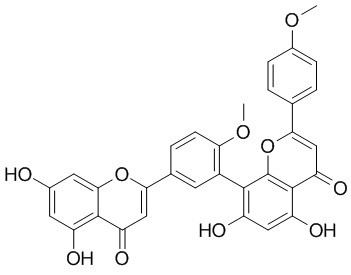Isoginkgetin
Isoginkgetin is a MMP-9 inhibitor, also a pre-mRNA splicing inhibitor with IC 50 of 30 uM. Isoginkgetin can up-regulate adiponectin secretion with potency comparable to that of rosiglitazone, a known modulator of adiponectin production. Isoginkgetin has anti-tumor activity, it can inhibit tumor cell invasion by regulating phosphatidylinositol 3-kinase/Akt-dependent matrix metalloproteinase-9 expression.
Inquire / Order:
manager@chemfaces.com
Technical Inquiries:
service@chemfaces.com
Tel:
+86-27-84237783
Fax:
+86-27-84254680
Address:
1 Building, No. 83, CheCheng Rd., Wuhan Economic and Technological Development Zone, Wuhan, Hubei 430056, PRC
Providing storage is as stated on the product vial and the vial is kept tightly sealed, the product can be stored for up to
24 months(2-8C).
Wherever possible, you should prepare and use solutions on the same day. However, if you need to make up stock solutions in advance, we recommend that you store the solution as aliquots in tightly sealed vials at -20C. Generally, these will be useable for up to two weeks. Before use, and prior to opening the vial we recommend that you allow your product to equilibrate to room temperature for at least 1 hour.
Need more advice on solubility, usage and handling? Please email to: service@chemfaces.com
The packaging of the product may have turned upside down during transportation, resulting in the natural compounds adhering to the neck or cap of the vial. take the vial out of its packaging and gently shake to let the compounds fall to the bottom of the vial. for liquid products, centrifuge at 200-500 RPM to gather the liquid at the bottom of the vial. try to avoid loss or contamination during handling.
Phytochemistry Letters2017, 449-455
Food Chem.2016, 191:81-90
Int Immunopharmacol.2020, 90:107268.
J Hematol Oncol.2018, 11(1):112
Anticancer Agents Med Chem.2023, 23(10):1204-1210.
Revista Brasileira de Farmacognosia2024, 34:1276-1286.
Plants (Basel).2020, 9(11):1535.
Metab Eng.2022, 75:143-152.
Int J Mol Sci.2023, 24(17):13230.
Front Cell Infect Microbiol.2018, 8:292
Related and Featured Products
J Biol Chem. 2008 Nov 28;283(48):33147-54.
The biflavonoid isoginkgetin is a general inhibitor of Pre-mRNA splicing.[Pubmed:
18826947]
Membrane-permeable compounds that reversibly inhibit a particular step in gene expression are highly useful tools for cell biological and biochemical/structural studies. In comparison with other gene expression steps where multiple small molecule effectors are available, very few compounds have been described that act as general inhibitors of pre-mRNA splicing.
METHODS AND RESULTS:
Here we report construction and validation of a set of mammalian cell lines suitable for the identification of small molecule inhibitors of pre-mRNA splicing. Using these cell lines, we identified the natural product Isoginkgetin as a general inhibitor of both the major and minor spliceosomes. Isoginkgetin inhibits splicing both in vivo and in vitro at similar micromolar concentrations. It appears to do so by preventing stable recruitment of the U4/U5/U6 tri-small nuclear ribonucleoprotein, resulting in accumulation of the prespliceosomal A complex. Like two other recently reported general pre-mRNA splicing inhibitors, Isoginkgetin has been previously described as an anti-tumor agent.
CONCLUSIONS:
Our results suggest that splicing inhibition is the mechanistic basis of the anti-tumor activity of Isoginkgetin. Thus, pre-mRNA splicing inhibitors may represent a novel avenue for development of new anti-cancer agents.
Traditional Chinese Drug Research & Clinical Pharmacology, 1993(2):12-4.
Effect of Isoginkgetin on Scavenge of Oxygen Free Radical in Anoxic Rats.[Reference:
WebLink]
METHODS AND RESULTS:
Chemiluminescence method and modified nitrous acid method were applied to determine the concentration of superoxide anion radical in plasma and erythrocyte of rats and the activity of superoxide dismutase(SOD) respectively. The results showed that Isoginkgetin (0.3mg/kg ip for 3d) could reduce the level of O2·- in plasma and erythroeyte (p<0.01) and sometimes increase the activity of SOD in anoxic rats, the action being stronger than aspirin.
Mol Cancer Ther. 2006 Nov;5(11):2666-75.
Isoginkgetin inhibits tumor cell invasion by regulating phosphatidylinositol 3-kinase/Akt-dependent matrix metalloproteinase-9 expression.[Pubmed:
17121913]
Matrix metalloproteinase (MMP)-9 plays a key role in tumor invasion. Inhibitors of MMP-9 were screened from Metasequoia glyptostroboides (Dawn redwood) and one potent inhibitor, Isoginkgetin, a biflavonoid, was identified.
METHODS AND RESULTS:
Noncytotoxic levels of Isoginkgetin decreased MMP-9 production profoundly, but up-regulated the level of tissue inhibitor of metalloproteinase (TIMP)-1, an inhibitor of MMP-9, in HT1080 human fibrosarcoma cells. Further studies showed that Isoginkgetin regulated MMP-9 production via PI3K/Akt/NF-kappaB pathway, as evidenced by the findings that Isoginkgetin inhibited activities of both Akt and NF-kappaB. PI3K/Akt is a well-known key pathway for cell invasion, and Isoginkgetin inhibited HT1080 tumor cell invasion substantially. Isoginkgetin was also quite effective in inhibiting the activities of Akt and MMP-9 in MDA-MB-231 breast carcinomas and B16F10 melanoma. Moreover, Isoginkgetin treatment resulted in marked decrease in invasion of these cells.
CONCLUSIONS:
In summary, PI3K/Akt is a major pathway for MMP-9 expression and Isoginkgetin markedly decreased MMP-9 expression and invasion through inhibition of this pathway.
This suggests that Isoginkgetin could be a potential candidate as a therapeutic agent against tumor invasion.
J Endocrinol. 2007 Sep;194(3):569-78.
Isoginkgetin enhances adiponectin secretion from differentiated adiposarcoma cells via a novel pathway involving AMP-activated protein kinase.[Pubmed:
17761896]
METHODS AND RESULTS:
We identified Isoginkgetin, a compound derived from the leaves of Ginkgo biloba, to up-regulate adiponectin secretion with potency comparable to that of rosiglitazone, a known modulator of adiponectin production. However, unlike rosiglitazone, peroxisome proliferators-activated receptor gamma activity seems not required for the action of Isoginkgetin, and Isoginkgetin has only a slight effect on adipogenesis, which makes it an attractive candidate for anti-diabetic treatment. Further investigation revealed that both Isoginkgetin and rosiglitazone activate AMP-activated protein kinase (AMPK) in adipocytes.
CONCLUSIONS:
Our findings suggest a novel mechanism for the elevation of adiponectin by Isoginkgetin, which is different from that of rosiglitazone. Furthermore, this novel mechanism for adiponectin regulation involving AMPK can potentially facilitate new understanding of metabolic diseases and identification of new targets, as well as agents that increase plasma adiponectin levels.



